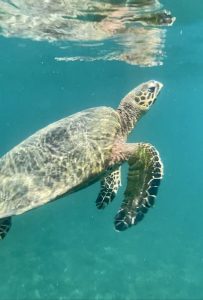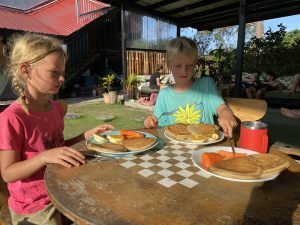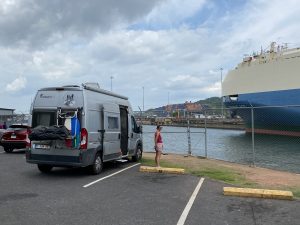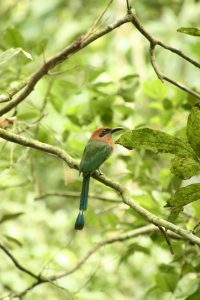 We spent three weeks in Panama but to be honest we did not see a lot of the country. A lot of the time was spent waiting until we were able to ship the van to Colombia. We will make a separate blog for that rather painful process. Also most of our time is spent at the few places that have a bit of elevation to escape the maddening heat and humidity.
We spent three weeks in Panama but to be honest we did not see a lot of the country. A lot of the time was spent waiting until we were able to ship the van to Colombia. We will make a separate blog for that rather painful process. Also most of our time is spent at the few places that have a bit of elevation to escape the maddening heat and humidity.
Entering Panama was the least pleasant border crossings so far. All the authoritarian behavior and plain unfriendliness that we expected in Nicaragua (but did not experience there) was served to us at the small border crossing for Panama. Our kids were looking with a mix of fear and astonishment at the migration officers barking orders at us. Luckily another (older & more polite) officer took care of their passports. The customs part (to import the van) took ages and in the end Caro basically almost filled out the documents herself in their computers.
 We had been looking into staying a couple of days at the islands of Bocas del Toro, one of the main tourism sites in Panama. But after suffering from the coastal heat for the last couple of days we decide to skip that and head straight to highland town of Boquete. We find a good camp to stay for a bit. Our Dutch friends John and Monique and also the Catalan family David, Nuria & kids are there. It seems we are not the only ones that have been suffering from ‘heat & humidity’ exhaustion… In the end we spent almost a week up there in the cool hills before we were able to pull ourselves away and descent back to the coast. There is a pool and a trampoline and play mates so the kids do not object to sticking around for a while. We do make one excursion for a hike to the ‘lost waterfalls’. A nice jungle hike where Leon spots another quetzal. We see it fly high above us in the treetops.
We had been looking into staying a couple of days at the islands of Bocas del Toro, one of the main tourism sites in Panama. But after suffering from the coastal heat for the last couple of days we decide to skip that and head straight to highland town of Boquete. We find a good camp to stay for a bit. Our Dutch friends John and Monique and also the Catalan family David, Nuria & kids are there. It seems we are not the only ones that have been suffering from ‘heat & humidity’ exhaustion… In the end we spent almost a week up there in the cool hills before we were able to pull ourselves away and descent back to the coast. There is a pool and a trampoline and play mates so the kids do not object to sticking around for a while. We do make one excursion for a hike to the ‘lost waterfalls’. A nice jungle hike where Leon spots another quetzal. We see it fly high above us in the treetops.
 As we would soon leave the Pacific Coast behind, to head up the Andes in South America, we were looking for a place where we could do a last session of tropical snorkelling. I also hoped to find a place for a couple of days of surf practice. Via a terrible road, we end up in Santa Catalina. This place is a bit of surfers heaven for the pro surfers but also has a nice beach break for beginners. And it is the start point for trips to Coiba National Park. And even though it was not the right season for the ‘big attractions’ (whalesharks, whales and giant mantas), the sharks, turtles, crocodiles and all kind of colorful fish made it really worth the trip for us.
As we would soon leave the Pacific Coast behind, to head up the Andes in South America, we were looking for a place where we could do a last session of tropical snorkelling. I also hoped to find a place for a couple of days of surf practice. Via a terrible road, we end up in Santa Catalina. This place is a bit of surfers heaven for the pro surfers but also has a nice beach break for beginners. And it is the start point for trips to Coiba National Park. And even though it was not the right season for the ‘big attractions’ (whalesharks, whales and giant mantas), the sharks, turtles, crocodiles and all kind of colorful fish made it really worth the trip for us.
However (and we know we sound like a broken record) after a second terribly humid night we bury our plans to spend some more time surfing here. We pack up the van and flee to the hills again.
 The closer we get to Panama City the less hills there are to be found, but we still find a place where the days maybe hot but at least, temperatures at night drop to about 22 degrees. Valle de Anton is a little town in the middle of an old collapsed volcano. We camp in the garden of a hostel where we are allowed to use all the facilities. The kids love the pancake breakfasts, the lounge chairs and the ‘giant Jenga blocks’ from which they make giant collapsing towers. Hours of fun! In the mean time we start cleaning out the van for shipment. We also visit the local hardware store and buy a wooden panel that we want to install as anti-theft solution for the shipment of the van.
The closer we get to Panama City the less hills there are to be found, but we still find a place where the days maybe hot but at least, temperatures at night drop to about 22 degrees. Valle de Anton is a little town in the middle of an old collapsed volcano. We camp in the garden of a hostel where we are allowed to use all the facilities. The kids love the pancake breakfasts, the lounge chairs and the ‘giant Jenga blocks’ from which they make giant collapsing towers. Hours of fun! In the mean time we start cleaning out the van for shipment. We also visit the local hardware store and buy a wooden panel that we want to install as anti-theft solution for the shipment of the van.
 We also find some time for a nice hike up to former crater rim where we get a nice view of the town in the crater and all the way to the ocean. We also visit a conservation center where they are working hard to try to bring the (in the wild) extinct ‘golden frog’ back.
We also find some time for a nice hike up to former crater rim where we get a nice view of the town in the crater and all the way to the ocean. We also visit a conservation center where they are working hard to try to bring the (in the wild) extinct ‘golden frog’ back.
 We enjoy the cool nights and relax hostel atmosphere a lot but eventually we need to come back down from the hills to head to Panama City. We don’t drive straight to the city but pass via the famous Panama Canal first. This engineering miracle is over 100 years old and just had a major update 10 years ago to accommodate the new giant ships. We go have a look at the San Pedro locks and are lucky to see two ships go through. The canal is so narrow in places that only one ship fits, so there is alternating one way traffic and in between the shifts there are quite long periods without any ships. We find a nice sleeping spot in the sleepy village of Gamboa where the local priest is inviting the visiting overlanders to use the church showers if they wish. We watch the ships (and trains) roll past us as the toucans fly over our head.
We enjoy the cool nights and relax hostel atmosphere a lot but eventually we need to come back down from the hills to head to Panama City. We don’t drive straight to the city but pass via the famous Panama Canal first. This engineering miracle is over 100 years old and just had a major update 10 years ago to accommodate the new giant ships. We go have a look at the San Pedro locks and are lucky to see two ships go through. The canal is so narrow in places that only one ship fits, so there is alternating one way traffic and in between the shifts there are quite long periods without any ships. We find a nice sleeping spot in the sleepy village of Gamboa where the local priest is inviting the visiting overlanders to use the church showers if they wish. We watch the ships (and trains) roll past us as the toucans fly over our head.
 The next morning, we get up early to visit ‘Soberania’ our last National Park in Panama and Central America. We walk part of the ‘plantation drive’ trail. This old road is now a paradise for birds and other wildlife. We (and our bird app) hear a lot of cool birds but unfortunately we are not able to spot most of them. Maybe that’s because our main spotter was looking more at the ground than in the trees. He does find plenty of cool miniature frogs.
The next morning, we get up early to visit ‘Soberania’ our last National Park in Panama and Central America. We walk part of the ‘plantation drive’ trail. This old road is now a paradise for birds and other wildlife. We (and our bird app) hear a lot of cool birds but unfortunately we are not able to spot most of them. Maybe that’s because our main spotter was looking more at the ground than in the trees. He does find plenty of cool miniature frogs.
 We had hoped to see some snakes too, but did not find any of those. Turns out we had to wait until we got to the city center to see another one of these. While we are parked in town, a man calls us and says there is a boa trying to strangle a big bird. In a tree just 20 meters away, we see a big boa constrictor wrapped around the neck and body of an adult cormorant. For a couple of minutes, we watch the bird struggle to get away. But it seems the life is slowly disappearing from his body. Just when we think it’s over, the snake can’t hold her grip on the branch anymore and they both drop down in the water below. And after some splashing around we see the bird swim away, while the snake is slowly retreating.
We had hoped to see some snakes too, but did not find any of those. Turns out we had to wait until we got to the city center to see another one of these. While we are parked in town, a man calls us and says there is a boa trying to strangle a big bird. In a tree just 20 meters away, we see a big boa constrictor wrapped around the neck and body of an adult cormorant. For a couple of minutes, we watch the bird struggle to get away. But it seems the life is slowly disappearing from his body. Just when we think it’s over, the snake can’t hold her grip on the branch anymore and they both drop down in the water below. And after some splashing around we see the bird swim away, while the snake is slowly retreating.
In the days/week after that we are mostly occupied with getting our van shipped to Colombia (we’ll make a separate post about that) but we do take the time to visit the ‘Casco Viejo’. This is the ‘old new town’ of Panama City. The original settlement was a couple of km further out but was completely destroyed by pirates after the raid of the infamous Henry Morgan in 1670. After that the town was moved to its current location.
It’s a nice place to spend a couple of hours but lacks the charms and architecture we have seen in other colonial towns. But maybe we were just too tired after traveling weeks in this hot and humid climate while trying to figure out the Echternach process/procession of shipping our van to Colombia.
